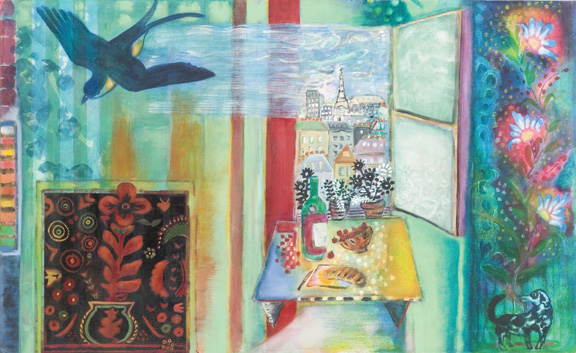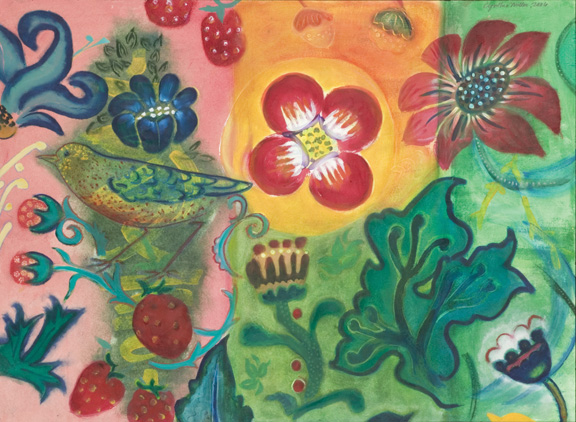Cynthia Miller
Curated by Ron Silliman
April 24 - May 31, 2008.
Cynthia Miller was born in Fond du Lac, WI. She has lived primarily in the Southwest Sonoran Desert since moving there as a child with her family in 1963. She studied creative writing, then painting, at the University of Arizona, Tucson, AZ and the San Francisco Art Institute, San Francisco, CA. In addition to thirty years of painting, past works include sculptural installations such as Yaqui Goes to LA at the Scottsdale Center for the Arts, Scottsdale, AZ in the early 1980s; collaborations on dance theatre projects with the Orts Theatre of Dance, Tucson, AZ; and ongoing book arts works with Chax Press. She has been teaching studio art to children and adults in the Tucson area for over twenty years and currently teaches for The Drawing Studio and for The Learning Curve, an independent Arts & Humanities forum. Her recognitions include the Arizona Arts Award and a Painting Fellowship from the Arizona Commission on the Arts. A member of the Tucson Artist Group (TAG) and Tucson Poetry Group (POG), she shares a studio and life with husband and poet Charles Alexander and their two daughters. The exhibition at CUE Art Foundation marks Miller's first solo show in New York.
Ron Silliman is a contemporary American poet. He has written and edited 32 books to date. Between 1997 and 2004, Silliman wrote a single poem, entitled The Alphabet. He has now begun writing a new poem entitled Universe, the first section of which appears to be called Revelator.
Silliman sees his poetry as being part of a single poem or lifework, which he calls Ketjak. Ketjak is also the name of the first poem of The Age of Huts. If and when completed, the entire work will consist of The Age of Huts (1974-1980), Tjanting (1979-1981), The Alphabet (1979-2004), and Universe (2005 - present).
Ron Silliman's fame and notoriety have grown considerably since 2002, due in large part to his popular and controversial weblog: Silliman's Blog. Debuting on August 29, 2002 to little fanfare and without expectations of an audience, it is now arguably the most influential English-language blog on the web that is devoted to contemporary poetry and poetics.
ARTIST'S STATEMENT
This current work includes mixed-media paintings on paper and on canvas. The combined materials of acrylic paint, chalk pastels with oil paint stick and graphite create an intensity of color layered with pattern and texture.
Imagery is derived from direct observation and invention. Inspired by a poetic impulse to examine the language of painting in the immediacy of daily life, the mostly long, horizontal paintings may include two or more unrelated images in a parataxis that points to a new paradigm.
Repeating motifs include natural elements of the Southwest desert region: pomegranates, antlers, birds and pinecones from the mountains, as well as simple houses, furniture and household goods. Patterns and objects depicted reference artworks as diverse as William Morris' wallpapers, Guatemalan pottery, Ukrainian folk art, and Native American textiles.
CURATOR'S STATEMENT
by Ron Silliman
Blending so-called high and low genre, the Arts & Crafts Movement anticipated much that we now think of as postmodern. Many of the forms that concerned William Morris, for example, including wallpaper, carpets and floor runners, were not only designed for domestic use, but also engaged visual traditions that deployed imagery as pattern, muting or deflecting the narrative of a "scene." Many other "Other" traditions likewise share exactly these features, from the Cubism of African sculpture to the pottery & tapestries of Central and South America, and of course the American Southwest. Tucson's Cynthia Miller, a painter whose work reproduced on book covers has been a visual signature of Chax Press for 20-plus years, pulls these different elements together with what I think she might call a Southwestern eye, and most definitely a Southwestern imagination.
The objects envisioned are simple - quail, a tea kettle, a flower pot - but seldom used simply. Rather, like the blue deer, the red pony or the red and yellow birds, each is cast so as to let in many possible connotations. Two crows represent two crows, yet they completely reframe the spatial relations of the two vases, one white, the other not (or the third vase, half hidden red against orange in the leftmost field). The result is a painting that conveys a sense of anxiety without ever telling why. Yet look at the lush leafwork about the crow on the right, or the transparent foliage about the darker vase.
The fields on which these translucent images sit are themselves visually rich, not unlike the flowers surrounding the road behind the blue antlers of Out West. The background tones often proceed from pink or red or red-orange to blue or blue-green. At times I think this figures the seasons, at times the hours in a day, at times I think it is there precisely to resist figuration.
View CATALOGUE
YOUNG ART CRITICS: Jennifer Duffy on Cynthia Miller






